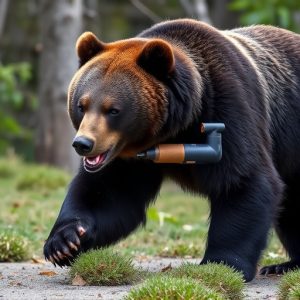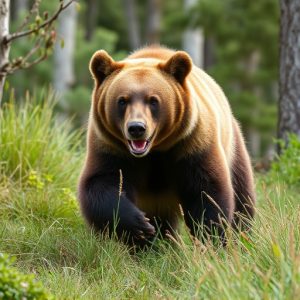Bear Spray Range: Maximizing Coverage and Effectiveness in Different Scenarios
Bear spray, a powerful deterrent against aggressive bears, uses capsaicin as its main ingredient. Wi…….
Bear spray, a powerful deterrent against aggressive bears, uses capsaicin as its main ingredient. With a maximum distance coverage of 20-30 feet (6-9 meters), its effectiveness is influenced by terrain, weather, and application technique. Ideal conditions allow for better range, but real-world usage may be shorter due to user panic. Precise aiming at the bear's face enhances its deterrence. While useful, bear spray should be a last resort; primary prevention includes maintaining distance, proper food storage, and using other deterrents like whistles and bells for added safety in bear country.
Bear spray is a popular deterrent for encounters with aggressive bears, but its effectiveness depends on various factors. This article explores the science behind bear spray, delving into its chemical composition and how it works. We analyze the key determinants of its range—terrain, weather, and application technique—and present research-backed maximum effective distances. Additionally, we offer practical tips for optimal coverage and consider alternative deterrents to enhance safety in bear country.
- Understanding Bear Spray: How It Works and Its Chemical Composition
- Factors Affecting Bear Spray Range: Terrain, Weather, and Spray Technique
- Maximum Effective Distance: What Research Says and Real-World Scenarios
- Application Tips for Optimal Coverage: Holding and Aiming Techniques
- Beyond the Range: Other Deterrents and Safety Measures to Consider
Understanding Bear Spray: How It Works and Its Chemical Composition
Bear spray, also known as bear repellent, is a powerful tool for self-defense against aggressive bears in their natural habitat. It’s a chemical aerosol designed to deter bears when faced with an encounter, particularly grizzly and black bears. The primary active ingredient in bear spray varies among brands but commonly includes capsaicin, the same compound that gives chili peppers their heat. This irritates the bear’s eyes, nose, and respiratory system, temporarily disorienting it and creating a safe opportunity to retreat.
The effectiveness of bear spray lies in its quick reaction time and wide range. Modern bear sprays can provide protection up to 20 feet (or 6 meters) or more, depending on the brand and weather conditions. This maximum distance coverage ensures users have a safety buffer during a potential encounter, allowing them to make decisions and move away from the bear safely. Understanding these factors is crucial when considering bear spray as part of your wilderness safety kit.
Factors Affecting Bear Spray Range: Terrain, Weather, and Spray Technique
The effectiveness of bear spray as a deterrent is influenced by several factors, with terrain, weather conditions, and application technique playing key roles in determining its maximum distance coverage. When considering bear spray maximum distance coverage, it’s crucial to understand that the open and flat the terrain, the further the spray can reach. Rough or uneven ground, dense foliage, and steep inclines can significantly reduce the range of bear spray by obstructing its path and causing it to disperse more quickly.
Weather conditions also impact bear spray range. In cold temperatures, air is denser, allowing for better retention of spray particles in the atmosphere, potentially extending its reach. Conversely, hot and windy weather can cause the spray to dissipate rapidly and spread out over a larger area, reducing its concentration at any given point. Additionally, proper application technique is paramount. Spraying bear spray directly towards the bearing animal’s face increases the likelihood of a successful deterrent effect, as it blocks the bear’s senses and causes temporary blindness and disorientation. Poor technique, such as spraying too high or too low, may result in the spray not reaching the target area effectively.
Maximum Effective Distance: What Research Says and Real-World Scenarios
The maximum effective distance of bear spray is a topic of both scientific interest and practical concern for those adventuring in bear country. According to research, the range varies depending on several factors, including the user’s movement, wind conditions, and the specific spray can. Studies suggest that under ideal conditions, bear spray can be effective up to 30 feet (approximately 9 meters). However, real-world scenarios often deviate from these optimal conditions.
In practical applications, the effective range might be significantly shorter due to the user’s panicked movements or unpredictable wind patterns. Even in the best-case scenarios, it’s crucial to remember that bear spray is meant as a last resort for self-defense. Maintaining a safe distance from bears and following prevention strategies like making noise while hiking and properly storing food are essential measures to avoid dangerous encounters.
Application Tips for Optimal Coverage: Holding and Aiming Techniques
To ensure optimal effectiveness, bear spray should be applied with precision and technique. When using bear spray, it’s crucial to understand that direction and distance are key factors in achieving maximum distance coverage. Hold the canister at arm’s length, pointing it directly towards the approaching bear. Aim for the face, eyes, and nose—these areas are highly sensitive, and direct contact can deter an aggressive bear more effectively than spraying from a distance.
Avoid spraying upward or too far ahead, as bears have a strong sense of smell and can detect the spray’s direction. Keep your body between the bear and the wind to maximize coverage on the target area. Practice these holding and aiming techniques during training sessions to build confidence and ensure you can deploy the spray quickly and accurately in real-life situations.
Beyond the Range: Other Deterrents and Safety Measures to Consider
While bear spray is an effective deterrent, understanding its maximum distance coverage is just the first step in ensuring your safety in bear country. Keep in mind that the range varies based on factors like wind, terrain, and spray concentration—typically ranging from 20 to 30 feet (6 to 9 meters). Beyond this range, other deterrents and safety measures become crucial.
Carrying other essential items like a loud whistle for emergency signals, a bear bell for warning bears of your presence, and knowing bear behavior can significantly enhance your overall safety. Additionally, storing food securely in bear-resistant containers and traveling in groups can provide extra layers of protection when venturing into areas known for bear activity.
Bear spray is an effective deterrent, but understanding its maximum range and optimal application techniques is key. Research indicates a typical bear spray can reach up to 30 feet (9 meters), but this can be influenced by terrain, weather conditions, and spray technique. Holding the canister at waist level and aiming directly at the bear’s face ensures maximum coverage. Beyond the stated range, other deterrents like noise makers and physical barriers should be considered for added safety in bear country. By combining these measures, outdoor enthusiasts can enhance their protection and enjoy a more secure experience in potentially risky environments.


